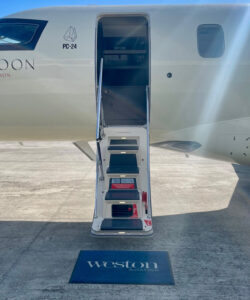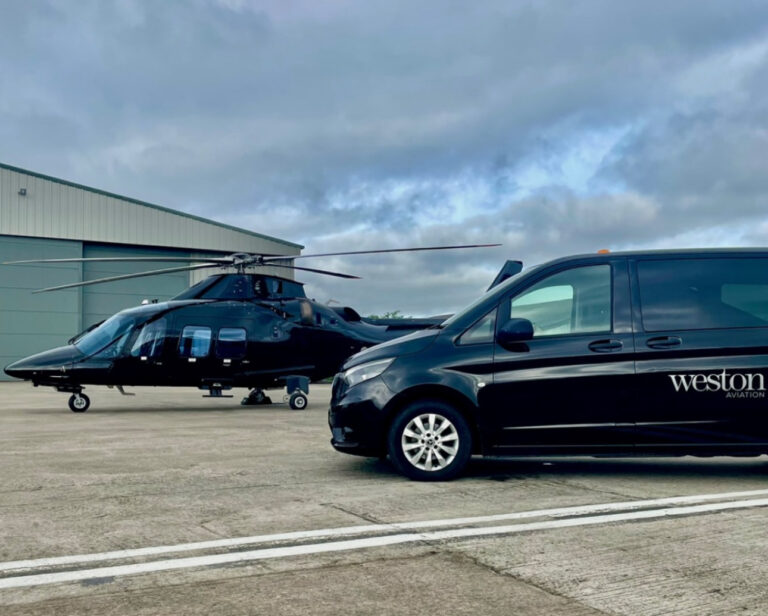FBOs often sell similar products and services as competitors at an airport and in a tricky market, it’s imperative for aviation players to differentiate themselves from the crowd. Today more than ever, the marketing and brand identity of every FBO has a make-or-break role in its success.
“A strong brand identity sets an FBO apart by conveying its values, quality of service and offerings,” says Joey Pehrson, managing director at Brisbane-based aviation marketing firm Off the Ground Marketing.
“Beyond the logo, it involves consistent messaging, a recognizable color scheme, a distinct tone of voice, and a memorable customer experience. It is about creating a cohesive story that resonates with clients, making them feel confident and connected to the brand.”
Formulating a brand

Last year, UK and Ireland-based aviation services specialist Weston Aviation rolled out its new brand identity. Its previous branding was 15 years old, and the company wanted a new offering that reflected the diverse services it offers, including FBO facilities and handling, passenger and cargo aircraft charter, fuel services, hangarage, network partnerships and consultancy.
“When pilots, aircraft owners and passengers recognize and associate positive attributes with an FBO’s brand, they are more likely to return and recommend,” says Nicole O’Connor, chief commercial officer at Weston Aviation. “A brand is never just about the logo alone – it’s the story behind it and the company’s journey.”
This is a view shared by Paula Williams, president and CEO at Aviation Business Consultants International (ABCI). Williams says a cohesive brand identity includes consistent messaging, a distinctive visual style and an engaging customer experience. This means ensuring every touchpoint – be it the website, social media, or in-person interactions – reflects the FBO’s core values and service promises.
“A cohesive brand identity and marketing approach build a strong, recognizable presence that resonates with customers,” says Williams. “This consistency fosters trust and reliability, encouraging repeat business and referrals.”
The role of marketing

Creating a brand identity and marketing it are two outputs that go hand-in-hand – and one cannot be successful without the other.
Effective marketing initiatives allow FBOs to connect with their target audience by communicating their value propositions clearly and consistently.
Digital marketing campaigns, social media engagement, email newsletters, and content marketing are all crucial in reaching potential customers.
“An integrated marketing strategy ensures that all efforts are aligned, maximizing the impact of each campaign and creating a seamless customer journey,” says Williams. “As a result, the FBO can achieve greater visibility, enhanced customer satisfaction and increased revenue, ultimately contributing to long term success.”
Williams adds that by leveraging data and analytics, FBOs can tailor their marketing efforts to the specific needs and preferences of their audience, leading to more meaningful interactions and higher quality leads.
“Engaging content, personalized communication and strong calls to action encourage prospective clients to take the next step – whether it’s booking a service or reaching out for more information,” Williams says. “We also advise engaging with other brands at the same airport, such as aircraft detailers, MROs, flight schools, airport authorities and community groups, to help promote the airport as a destination and the FBO as a good neighbor.”
Marketing initiatives are also important to FBO network Signature Aviation.
The company launched its new visual identity earlier this year to communicate its focus on hospitality and create an exceptional experience for every guest.
Derek DeCross, CCO at Signature Aviation, says the logo is a symbol for the focus on hospitality and helps to ensure that the focus this is communicated through Signature’s updated messaging, visual elements and everyday guest interactions.
“Marketing initiatives play a crucial role in engaging with our diverse audience,” says DeCross. “By leveraging various owned, paid and earned channels such as digital marketing, social media, events and partnerships, we create compelling content and experiences that provide value and resonate with our audience.
“Personalized communications, tailored pricing programs, and proactive outreach deepen our relationship with guests, enriching their experience with transparency and up-to-date information, such as travel alerts.”
Challenges and collaborating
Developing a brand identity and then implementing effective marketing strategies to reflect it isn’t an easy task.
Challenges include understanding the target audience, differentiating from competitors, limited marketing budgets, a lack of in-house expertise and keeping up with industry trends.

“To overcome these, FBOs should invest in market research, stay adaptable, and continuously gather feedback from customers,” says Pehrson.
“Partnering with experienced marketing professionals can also provide valuable insights and innovative strategies to stay ahead.”
Williams says focusing on unique selling points and customer testimonials can help build a compelling
brand narrative.
“Regularly updating and optimizing marketing strategies based on performance metrics ensures continuous improvement and relevance.
“Having a brand kit and a usable and enforced brand brief can help make it easy to work with vendors and team members to enlist their help in promoting the brand.
“Collaboration with industry influencers and partnerships can also extend reach and credibility.”
There have been notable collaborations announcements in 2024 already. In May, Farnborough Airport partnered with luxury jewelry company Lugano on a newly refurbished and designed Lugano Lounge and a branded wrap of the airport’s radar tower. The banner is 18m high and 18m wide and is the largest airside advertisement site at any UK airport.
Similarly, NetJets recently launched its multi-year collaboration with famed Scottish golf club The R&A, and Castle Air announced its partnership with Partridge BMW.
Collaboration helps to amplify a company’s brand by showing its operation is worthy of partnering with high profile businesses, as well as boosting the customer offering.
“Customers tend to associate a strong brand with superior service and professionalism,” adds O’Connor. “As we develop our partnership scheme The Collection and other collaborations, a reputable brand identity also enhances the creation of these alliances.”
The significance of strategy
It’s evident that formulating the perfect brand identity is a big job, but is it worth it? O’Connor believes so.
“A clear brand identity has streamlined our marketing efforts, right through to our operational practices, the way we welcome our passengers and the uniforms that we wear,” she says.
“With well-defined brand guidelines, all marketing materials can be produced more efficiently and consistently. These guidelines also create trust, credibility and turn behaviors into passion for both our customers and staff.”
DeCross agrees, noting that work to establish Signature’s new brand and visual identity is a key part of its transformation as a hospitality company.
“Ensuring the brand delivers on its promises is paramount,” DeCross explains. “Because our brand updates worked in concert with other transformations throughout our business, a culture has been fostered where every guest interaction reflects our commitment to excellence.
“We also recognize the evolving landscape of guest preferences and expectations, influenced by technological advancements, demographic shifts, and changing travel trends. To address this, we embrace innovation and leverage emerging technologies across our network, aiming to elevate every aspect of our business and exceed the expectations of our guests.”
How to create a brand identity

A cohesive brand identity and marketing approach builds trust and recognition, leading to increased customer loyalty and word-of-mouth referrals. It ensures that all touch points with the customer are aligned and reinforce the brand’s values and promise – and this consistency helps establish a strong market presence and drives long-term success.
When creating a brand identity, Pehrson says consistency is key. “Ensure that a brand message, visuals and tone of voice are consistent across all platforms and communications.
“Use social media and other interactive platforms to engage directly with your customers, respond to their feedback, and build a community around your brand,” says Pehrson. “Create high quality, informative content that showcases your expertise and adds value to your audience. This positions your FBO as a thought leader in the industry,” he says.
Williams recommends engaging with experienced branding professionals to develop a strong, cohesive brand identity that truly represents the FBO’s values and services – this includes a memorable logo, a consistent color palette, and a unified message across all platforms.
“Look at everything your clients and passengers touch – even things that aren’t typically used for advertising,” adds Williams. “You can wrap airplanes, buses, trains, shuttles or golf carts with your brand imagery to create moving billboards for your brand. You can also create branded packaging for food and beverages such as paper cups, takeout boxes or wrappers.”
FBOs could also create a classroom lesson or a merit badge program and invite children to its facility one day per quarter or per year, making sure they go home with branded swag and have a photo opportunity with a plane, tug or interesting piece of equipment.
“The more unexpected, the more effective your branding can be,” concludes Williams.





